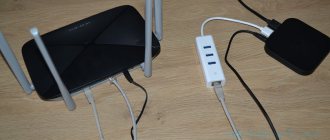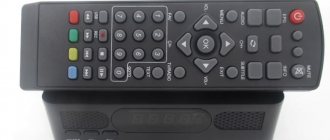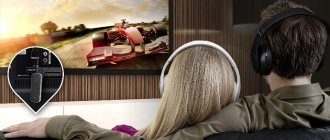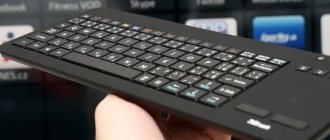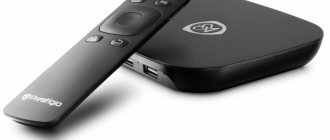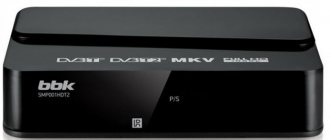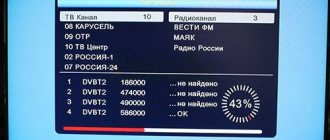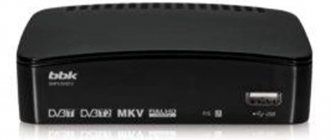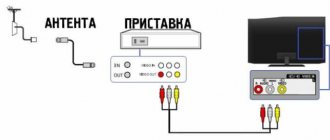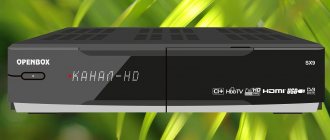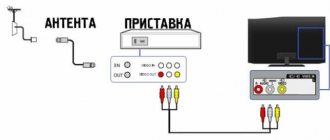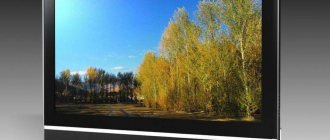Quite often when choosing a TV, we are faced with digital standards that are embedded in one or another type of tuner. However, not everyone can obtain the necessary information using the abbreviation specified in the characteristics. Most likely, this is due to the fact that ordinary consumers do not pay much attention to these technical issues and, in principle, are not interested in digital broadcast formats. Of course, this parameter in the technical specifications does not have privileges over screen resolution or matrix type, but it is still useful to know about it.
Before moving on to the analysis of digital standards, a definition should be given in order to understand why a digital tuner is needed on a TV?
A tuner (also called a decoder, decoder or digital receiver) is a device that allows the TV to play broadcast video streams by receiving and decoding signals of different broadcast formats. According to their design, they can be external or internal (built-in).
In modern TVs, the built-in decoder usually supports several broadcast standards, which manufacturers describe in the technical specifications for a particular model. Keep in mind that you should still choose a TV based on its main characteristics, and if the built-in tuner in the model you like does not support the necessary standards, then you are always free to buy an external one.
At the same time, having a tuner on your TV that supports the standards you need can, in some cases, save you from additional costs.
Digital television broadcast standards.
There is an international organization for standardization (ISO - International Organization for Standardization) which includes national standardization committees from more than 100 countries. Special groups have been formed there to solve problems in individual industries. Today there are the following basic standards:
- DVB is a European digital television standard.
- ATSC is an American digital television standard.
- ISDB is a Japanese digital television standard.
Of course, we are interested in the DVB group (Digital Video Broadcasting - digital video broadcasting).
DVB-C . Cable digital television standard. To access the package of channels, just insert your provider card into the tuner. This standard is based on MPEG-2 coding of moving images and audio.
DVB-C2. This is the second generation of the above-mentioned standard, which provides a low-cost option for upgrading such a network. In addition, it uses OFDM instead of a single carrier, which provides additional flexibility and noise immunity.
DVB-S. Digital satellite broadcasting. The signal is transmitted via satellite, and for reception you need a satellite dish and a decoder. This digital broadcasting has been and remains the fastest, most reliable and economical way to transmit a high-quality TV signal to any point in a vast space.
DVB-S2. A modified DVB-S standard that covers the shortcomings of its predecessor. One of the important reasons for the creation of the new standard was plans for the mass launch of HDTV. Since the structure of the transport frame is not tied to a specific format, it is possible to transmit both MPEG-2 transport packets and arbitrary streams with a continuous or packet structure.
DVB-T. Digital terrestrial television. Here the signal is transmitted over the airwaves and received by an individual (room) or collective antenna, which is connected to a TV with a built-in decoder or to a receiver that supports this standard. The work is carried out in the UHF (decimeter waves) or MV (meter waves) range.
DVB-T2. Accordingly, this is the second generation of the previous standard, which is fundamentally different from it. This improved type allows TV channels to broadcast programs not only in HDTV format, but also transmit a signal in 3D format. The type of audio and video compression in the international MPEG4 standard is supported. This technology improves throughput by more than 30%, as well as transmission stability.
If this is your first time hearing about the DVB-T2 standard, then watch the video.
As you can see, there is nothing complicated in these abbreviations for a non-technically savvy person. The letter T - (Terrestrial) stands for terrestrial broadcasting, C - (Cable) for cable, and S - (Sattelite) for satellite. If your TV supports any of the digital standards mentioned above, then you will still need to purchase a CAM module. As a rule, all modern models have a CI/PCMCIA slot on the back for pairing a CAM module and an access card from your provider.
However, the purchase of such a kit in some cases is not always justified, but it allows you to watch encrypted channels. For example, if your model supports the DVB-S2 standard, but you do not have a module and an access card, then by connecting a satellite dish to your TV, you will only be able to find completely open channels. Alas, there are practically no really interesting ones in the public domain, and the cost of a set for TV (module + sim + subscription) sometimes exceeds the cost of a good receiver.
That's all. If you want to express your opinion or add to the publication, then express your thoughts in the comments.
If you find an error, please select a piece of text and press Ctrl+Enter.
A TV tuner is needed to receive a signal and then transmit the image to a television monitor or computer. Let's talk about their types and selection criteria.
Special features of dvb c
- Data compression as well as MPEG-2 multiplexing (MUX) In dvb c, video, audio and data streams are multiplexed into an MPEG/ MPEG-PS program stream. Then they are combined into an MPEG transport stream. This is the same stream received by digital television receivers. MPEG transport stream transmission rates range from 6 to 64 Mbits per second.
- MUX adaptation and subsequent MPEG-TS power dissipation should be considered as a sequence of data packets having a fixed length of 188 bytes. This sequence undergoes decorrelation after energy dissipation.
- Processing by external encoder The data stream receives level 1 protection. They are encoded using a binary block code (Reed-Solomon code). This allows up to eight bytes to be corrected for every 188-byte data packet.
- Processing by external interleaver Data rearrangement is carried out by interleaving. Thus, the stream becomes more resistant to the appearance of long sequences of data with errors.
- Byte/m-tuple conversion Encodes byte sequences into a group of related bit data.
- Differential Encoding Encoding each character using Most Significant Bits allows you to achieve a set of invariations.
- QAM mapping The DVB-C format using bit mapping is represented by 5 types of modulations: 16-QAM, 32-QAM, 64-QAM, 128-QAM, 256-QAM.
- Baseband shaping The QAM signal is filtered. This makes it possible not to encounter overlapping different signals when setting up the receiver.
- DAC and Pre-Dial Processing A signal converter helps convert a digital signal into an analog signal. Then, thanks to RF post-processing, modulation into the broadcast network occurs.
What is a TV tuner
A modern digital tuner is multimedia equipment with extensive functionality (video recording, TV program, scheduler), intended primarily for decoding and displaying television programs.
- Record live broadcasts from TV and store information in memory. Receivers have a special scheduler. It automatically starts recording the desired image at a specific period of time. In TimeShift mode, you can move through the recording in both directions: review the moments you liked, and then return to the standard timeline. In the same mode, the user will be able to change the playback speed: slow down or speed up if necessary.
- An FM receiver can be built into the TV tuner, and therefore you can use it to listen to the radio.
- Go-TView – connection to a TV program via a tuner. The user will be able to see the list of programs for the week and find a specific channel, for example “Sports” or “Culture”. Using synchronization, all commercials are cut from the saved video.
- Scheduler. By connecting to the program guide, you can activate a special function that will remind you or save an interesting broadcast at the right time. The program will automatically check whether several desired gears will overlap, and if necessary, open a menu where you can adjust the settings.
- Blocking channels. This feature is known as Parental Controls.
How to disable Digital TV Tuner device registration application
You can remove Digital TV Tuner device registration application from your computer by disabling Windows Media Player components.
Instructions for removing Digital TV Tuner device registration application :
- Universal USB digital television tuner DVB-C/T/T2 for Windows and Android devices
- Go to “Control Panel” from the “Start” menu or through the standard Windows search;
- Activate the “Large icons” or “Small icons” item in viewing mode;
- Click “Programs and Features”;
- In the left side column, click “Turn Windows features on or off”;
- Find the item “Components for working with multimedia” in the list and expand it (English: Media Features);
- Uncheck “Windows Media Player”;
- In the window that appears, confirm the disconnection by clicking on the “OK” button.
This is how you can simply disable the Digital TV Tuner device registration application. If suddenly this service becomes necessary again, you can easily enable it by re-activating the unchecked box.
Types of TV tuners
In stores you can only find a digital tuner for a TV, since analog types have fallen out of use, and previously they were designated by NTSC, PAL, SECAM formats. Set-top boxes differ in broadcast standard, type of connection to a TV or computer, and operating system support.
According to broadcast standard
A digital tuner receives a television signal and decodes it depending on broadcast standards, including the following:
- DVB-T is an outdated terrestrial digital broadcasting format that is not used today;
- DVB-T2 – terrestrial digital broadcasting, an improved version of the previous format. Bandwidth has been increased, as has resistance to interference, which allows you to transmit images to screens in HD quality;
- DVB-C – reception of cable digital television. The format is more common in the CIS, Asia and Europe;
- DVB-S – satellite digital broadcasting;
- DVB-S2 is an improved version of the previous broadcast with greater capacity and resistance to interference.
Connecting and setting up dvb c
On digital and smart TVs that support cable TV, everything is done quite simply. In the settings, you need to select the source of the received signal and enable auto search. In the case when we are talking about working channels of another broadcast, everything is done manually.
The user should go to “System settings” and select – 256 QAM module and speed 6875 KS/s. Don't forget about the channel's operating frequency. If TVK values are available, they are simply entered. But when they are not there, the following is usually done. The entry of the minimum value of the UHF range begins - 298,000 kHz. With each subsequent time there is an increase of 8000. The final frequency of digital broadcasting is 858,000 kHz. The search starts at 170,000 kHz when both digital and analogue channels are being monitored.
On the receiver, the setup will occur in a very similar way. First you need to switch to the channel corresponding to the special connector. It is to this that the console is connected. When using a Smart Receiver, it is also important to find the signal source. The signal from cable television must be free of interference and of high quality. If unsuccessful, you should check the cable or find out if there are any problems on the part of the provider. Older TV models may have low picture resolution. If there is no image at all, then it is worth checking whether the wires are connected correctly, and whether the desired TVC is selected on the TV.
What to look for when choosing an external tuner
When choosing the right TV set-top box, you need to consider the following:
- Connectors. You need to select those that are present on your home computer or TV, otherwise you will have to additionally look for adapters. In order for the monitor to receive high-quality images, it is important to have an HDMI port.
- Availability of PVR function. If the tuner supports this extension, then it will be able to record any broadcasts from the TV at the appointed time. The user will independently decide how long this file needs to be stored in the equipment memory. In this way, delayed viewing can be performed.
- Availability of a USB port. Often people want to use a tuner not only to connect to digital television, but also to watch movies that can be downloaded to the TV via a flash drive.
- DVB-T2 format support. You should not buy a model with DVB-T preceding it. This is a waste of money, since this standard is no longer supported in the Russian Federation.
These functions are enough for the average user for comfortable viewing.
TV set-top box dvb c - who should buy it?
The DVB-C TV set-top box is capable of producing a picture with high quality - the image is transmitted without ripples or interference. Modern set-top boxes help convert analogue to digital. The device only works when the wire is connected. The device is worth purchasing if there is an operator of the services he needs in the user’s home. It will allow you to watch many channels with excellent quality. The set-top box will also be needed by those who have analogue cable television in their apartment or house. The presence of a set-top box will help quickly solve this problem, providing a good signal level.
Software is the most important thing in tuners
The installed firmware is the most important part of the device, because it is what ensures the functioning of the device. Each TV tuner is equipped with standard software, thanks to which the device will perform a variety of functions:
- automatically record specific programs at specified times;
- adjust image quality;
- display an image on several screens simultaneously.
If you need additional features, you will have to look for more expensive tuners with advanced functionality.
How to get rid of other device components and viruses
Users of Android gadgets often use the online store to download various applications. After they are no longer needed or free space needs to be freed up, the programs are uninstalled, but if this is done incorrectly, some data will be retained. For example, you need to remove Find my device, and for this:
- SDRsharper or another program for RTL SDR
- You will need to go to the main menu of the gadget.
- Here you should select “Settings” or “Application Manager”.
- A list of all installed programs will open.
- If the name you are looking for is not available, you can activate the “Options” button in the upper right corner and click on “Show system applications”.
- After going to the program menu, you will need to press the “Memory” button, and then “Clear data”.
- After clearing the cache, you should go back a step and activate the “Delete” button.
Users began to notice the “Digital TV Tuner device registration application” program in the task manager in active processes. Many people don’t know what it is and whether it can be removed, so we will look at this issue in this article.
Program that slows down your computer
Which external tuner to choose
Electronic stores have a sufficient number of tuners with various parameters.
Judging by reviews online, the following devices turned out to be the most reliable in their price category.
TOP 3 best budget DVB-T2 models for terrestrial TV
World Vision Premium. An easy-to-use device. A large display is mounted on the front side, from which information is easy to read. The TV tuner control panel is ergonomic. Built-in power supply. It will not get very hot during operation.
Harper HDT2-1202. Connects to old and new generation TVs. A miniature model that will not take up much space when installed on a TV receiver located in the kitchen or children's room.
Selenga HD950D. Equipped with an MStar 7T01 processor, which increases the channel switching speed compared to other similar models. The set includes a smart remote control that can be configured to control other TVs.
The best budget model for satellite TV
World Vision Foros Combo T2/S2 is a suitable and convenient option for connecting to satellite television. Hassle-free, simple and inexpensive, this receiver's recipe for success is simple. On the equipment you can watch video from a flash drive in HD in any format thanks to the built-in player.
Thanks to the supported T2-MI standard, the user will be able to view federal channels from satellite for free. This is a useful feature for people living far from television centers.
The best budget model with USB for a smartphone
AVerMedia Technologies Mobile 510 is a compact model that works with Android OS and will turn a smartphone or tablet into a full-fledged TV.
The antenna comes complete with a suction cup; with its help, the structure is attached to glass or directly to a phone or tablet.
Unfortunately, not all old or budget TVs have a built-in tuner for digital or cable broadcasting. A tuner is necessary to ensure that received TV programs are converted to your TV or computer in decent quality. Such a signal decoding device reformats four-line scan into modern progressive and converts video formats.
A good digital receiver not only improves picture quality, but also increases data transfer speed. Below we will look at the types of digital TV tuners, pay attention to the choice and offer the 5 best models of the current year.
Types of TV tuners
First classification of tuners:
- analog (receive signals from traditional TV broadcasting);
- digital (designed to receive digital signals).
Second classification of tuners:
- terrestrial broadcasting (for television antennas and DVB-T and DVB-T2 standards - the second for a terrestrial repeater (RTRS tower));
- for cable broadcasting - DVB-C;
- satellite broadcasting (for satellite antennas and DVB-S and DVB-S2 standards);
- combined (several receivers on one board).
Classification of tuners by resolution:
- SDTV (Standard Definition), not supported in Russia;
- EDTV (Enhanced Definition), not supported in the Russian Federation;
- HDTV (High Definition Television) is high definition television supported in Russia.
Tuners by connection type:
- to a computer monitor;
- to the TV;
- combined.
In this case, it all depends on the set of connectors: HDMI (for several devices), RCA (for TV); USB.
Other ways to fix Digital TV Tuner problems
If your computer continues to run slowly due to Digital TV Tuner device registration application and you don't know what to do about it, then follow these recommendations:
- open your anti-virus software, check if there are any player components in the “Quarantine” section, otherwise they will need to be restored;
- run a virus scan of your entire hard drive;
- check the integrity of the files using the sfc /scannow utility via the command line;
- download special programs for cleaning and defragmenting your hard drive and Windows registry;
- use system restore points or restore the OS using a boot disk.
Summary
Article NameDigital TV Tuner device registration application - what it is and how to remove itDescriptionUsers began to notice the “Digital TV Tuner device registration application” program in the task manager in active processes. Many people don’t know what it is and whether it can be removed, so we will look at this issue in this article. Author Igor Publisher Name Igor Publisher Logo
Sources used:
- https://urfix.ru/udalit-digital-tv-tuner-device-registration-application/
- https://xn—-7sbbnvnbd8df8h.xn--p1ai/kak-udalit-devices.html
- https://itdesc.ru/digital-tv-tuner-device-registration-application-chto-eto-takoe-i-kak-ego-udalit/
TOP 5 TV tuners 2021
TV tuner Selenga HD950D (from 788 rubles)
This budget model supports digital broadcasting standards: DVB-C, DVB-T, DVB-T2. It has a clear interface and good functionality (for its low cost).
Set up and connect to Wi-Fi quickly and conveniently. The model has 2 USB connectors, the tuner reproduces sound in AC3 quality (Dolby Digital), and connects well to a hard drive and other external sources. You can update the firmware by going to the manufacturer's website.
Convenient controls compensate for imperfect build quality. Users recommend this tuner for older and non-widescreen TVs - then the image quality will please you.
- Type: external stand-alone type;
- Video capture: absent;
- Resolution support: 720p, 1080i, 1080p;
- Progressive scan: yes;
- Video format: 4:3, 16:9;
- Maximum frequency: 60 Hz;
- Support of digital standards: DVB-C, DVB-T, DVB-T2;
- Interfaces: audio, HDMI 1.3; USB 2.0; composite;
- Functionality: Dolby Digital; deferred viewing; parental controls, teletext, external HDDs;
- Included: power supply, batteries, cable, remote control, documentation.
- low price;
- image clarity;
- supports two broadcast standards;
- HD 1080p resolution support;
- functional;
- speed of setup;
- convenient control;
- equipment;
- AC3 sound format;
- presence of a display;
- accepts flash drives;
- There are new firmwares on the manufacturer's website.
- lack of Wi-Fi adapter (purchased separately);
- build quality is not ideal;
- metal legs scratch the surface of the cabinet/table;
- when recording one channel, not all channels are turned on;
- does not support the satellite broadcasting standard;
- does not read DTS audio format;
- no “working days” mode;
- the clock is slow;
- the clock burns very brightly;
- gets a little warm;
- short non-removable power cord.
TV tuner D-COLOR DC1802HD (from 1220 rubles)
Very compact, modernly designed tuner with display. Designed for viewing digital television in DVB-T and DVB-T2 standards, as well as DVB-C cable broadcasting. This model is connected to the TV via a composite input (“tulips”) or an HDMI cable. Using the USB port, you can watch movies from a flash drive or other digital media. The tuner records broadcasts, as it is equipped with PVR functionality for recording a video stream at a specified time.
Disabling Digital TV Tuner registration application
Some Windows services can overload the computer, but they are useless to the user. The list of resources that slow down the process often includes Digital TV Tuner devices application. Before deleting it, you should make sure that the application is really no longer needed in the future.
- Wintel CX-W8, what it is and what you can do with it.
The digital TV receiver registration program is part of the standard Media Player. The workload is increasing for several reasons. It may be associated with damage to system files or the installation of malware that has modified a component and uses it for its own purposes. To understand whether the application is working normally or if there are any problems, it is recommended to use the Cleanup utility from Avast.
It is easier to disable Digital TV Tuner through the Control Panel:
- You need to go to the Control Panel by simultaneously clicking on the Win + R keys and typing “control.exe” in the window without quotes. Confirm the action by clicking “Ok”. Select the “Programs and Features” section.
- In the menu on the left you will need to click on the command “Turn Windows features on or off”.
- A window will open with a list, among which there will be a section “Components for working with multimedia” (or “Media Features”).
- Next to “Windows Media Player” you will need to uncheck the box.
- The system will issue a warning; you must agree to disable it by clicking “Ok”.
Note! The problem is most often observed on Windows 7, Vista and XP.
Some Windows utility tools may appear out of nowhere at first glance. When working with a PC, a user may notice a certain virtual CD-Rom, although he has not installed anything like that. To remove Dtsoft Virtual CD-Rom device, it is recommended to use Device Manager. If this does not bring positive results, you can try uninstalling using the registry database or Daemon Tools Lite. The fastest way to delete a virtual disk is through the application:
- After installation, launch Daemon Tools Lite.
- In the window that opens, right-click on the bottom field and a context menu will appear where you have several actions to choose from: adding or removing a conditional drive.
- In our case, we need to select the “Delete all” command. This will get rid of all previously installed conditional disks.
- Confirm the action by clicking on “Ok”.
